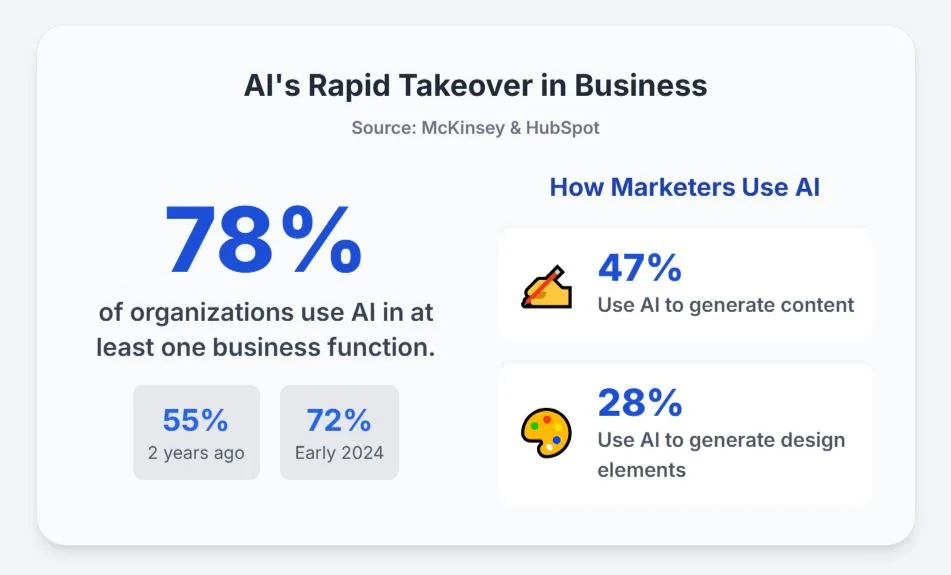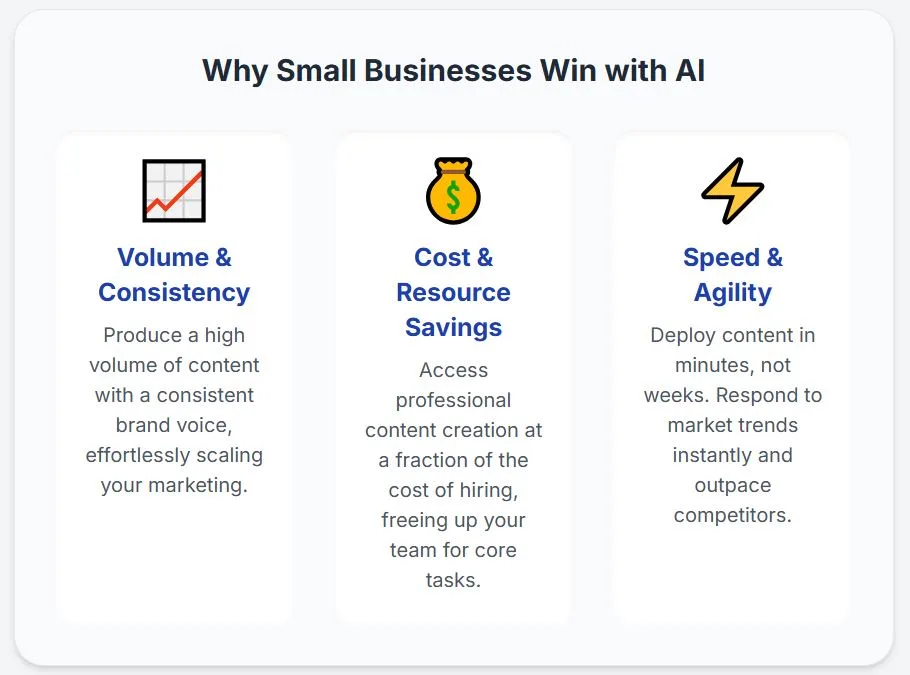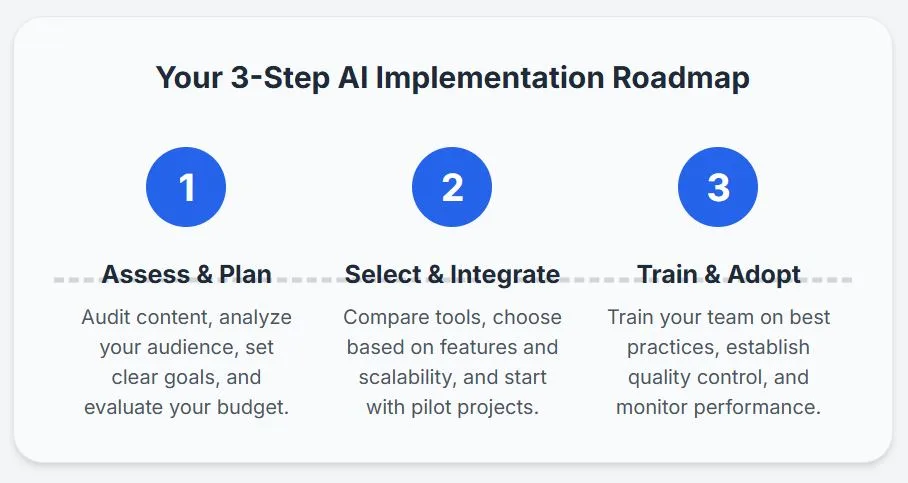 This comprehensive guide explores the revolutionary world of AI-powered content creation, specifically examining how AI article writers and free AI content generators are transforming digital marketing for small businesses. We’ll dive deep into market trends, practical applications, cost-benefit analysis, and strategic implementation approaches while addressing common concerns about authenticity and quality. Small business owners will discover how these cutting-edge technologies can level the playing field against larger competitors, streamline content operations, and drive measurable growth in their online presence.
This comprehensive guide explores the revolutionary world of AI-powered content creation, specifically examining how AI article writers and free AI content generators are transforming digital marketing for small businesses. We’ll dive deep into market trends, practical applications, cost-benefit analysis, and strategic implementation approaches while addressing common concerns about authenticity and quality. Small business owners will discover how these cutting-edge technologies can level the playing field against larger competitors, streamline content operations, and drive measurable growth in their online presence.
The digital marketing landscape has undergone a seismic shift in recent years, with artificial intelligence emerging as the catalyst for unprecedented transformation. As small businesses struggle to maintain competitive content strategies on limited budgets, AI article writer technology has become the great equalizer, offering sophisticated content creation capabilities previously exclusive to large enterprises. This technological revolution extends beyond simple automation, fundamentally changing how businesses approach content strategy, brand storytelling, and customer engagement.
The emergence of AI-powered content creation represents more than just a technological advancement—it’s a paradigm shift that’s reshaping the entire content marketing ecosystem. According to Grand View Research, the AI Powered Content Creation Market size was valued at USD 2.10 Billion in 2023 and is expected to grow at a CAGR of 17.63 percent from 2024 to 2030, reaching nearly USD 6.54 Billion in 2030, demonstrating the massive industry confidence in these technologies. This explosive growth reflects the urgent need for scalable, cost-effective content solutions that can keep pace with the ever-increasing demand for digital content across multiple channels and platforms.
Understanding the historical context and current state of these technologies provides crucial foundation for businesses considering AI implementation. The evolution from basic automation to sophisticated content generation has created unprecedented opportunities for small businesses to compete effectively in the digital marketplace.
The Evolution and Current State of AI Content Creation Technology
The technological revolution in content creation didn’t happen overnight, but rather through decades of incremental advances that culminated in today’s sophisticated AI article writer systems. Understanding this progression helps businesses appreciate both the capabilities and limitations of current tools while preparing for future developments.

Historical Development and Market Trajectory
The journey of AI content creation began in earnest around 2015, when early natural language processing (NLP) models started showing promise in generating coherent text. However, the real breakthrough came around 2019 when advanced transformer models and deep learning architectures began producing content that approached human-level quality. This period marked the transition from experimental AI article writer tools to commercially viable AI content generator free platforms that small businesses could actually implement.
The technological foundation underlying modern AI content creation rests on sophisticated machine learning algorithms that have been trained on vast datasets encompassing billions of words from diverse sources. These systems learn patterns in language, style, and structure, enabling them to generate contextually appropriate content across various formats and industries. The advancement from rule-based systems to neural networks represents a quantum leap in capability, allowing AI article writer tools to understand nuance, maintain consistency, and adapt to specific brand voices.
According to Research and Markets, the AI Content Creation Market size was valued at USD 8.5 Billion in 2024 and is forecasted to grow at a CAGR of 13.4 percent from 2026 to 2033, reaching USD 24.6 Billion by 2033, indicating sustained market confidence and investment in these technologies. This growth trajectory reflects not just technological advancement but also widespread business adoption and proven ROI for companies implementing AI article writer solutions.
The current market landscape reveals both the maturity of existing technologies and the exciting potential for future innovations. As we examine adoption rates and market penetration, it becomes clear that businesses are moving beyond experimental phases into full-scale implementation.
Current Market Landscape and Adoption Rates
The contemporary AI content creation ecosystem encompasses a diverse range of solutions, from free AI article generator tools that provide basic functionality to sophisticated enterprise platforms offering advanced customization and integration capabilities. According to McKinsey’s State of AI report, 78 percent of respondents say their organizations use AI in at least one business function, up from 72 percent in early 2024 and 55 percent a year earlier, demonstrating rapid adoption across industries.
Small businesses are particularly well-positioned to benefit from this technology revolution. Unlike larger corporations that may face bureaucratic hurdles or legacy system constraints, small businesses can quickly implement and iterate with AI content tools. The democratization of advanced content creation capabilities means that a local bakery can now produce professional-quality blog content, social media posts, and email campaigns that rival those of multinational corporations.
The current market offers unprecedented choice for businesses seeking AI content solutions. From specialized AI article writer tools focused on specific content types to comprehensive platforms handling multiple formats, the ecosystem has matured to address virtually every content need. This diversity ensures that businesses can find solutions that align with their specific requirements, budget constraints, and technical capabilities.
As we move beyond understanding the market landscape, it becomes essential to examine the specific categories of AI content tools and their respective strengths and limitations. This analysis will help businesses make informed decisions about which solutions best serve their unique needs.

Understanding the Spectrum: AI Article Writers vs. Free AI Content Generators
The AI content creation market has evolved to offer distinct categories of tools, each designed to serve different business needs and budget constraints. Understanding these differences is crucial for making strategic decisions that align with your business objectives and growth plans.
Defining the Categories and Capabilities
The distinction between premium AI article writers and free AI content generators extends far beyond simple pricing models. These categories represent different approaches to content creation, each with unique strengths, limitations, and optimal use cases. Understanding these differences is crucial for small businesses making strategic decisions about their content creation infrastructure.
Premium AI article writers typically offer sophisticated features including:
- Advanced Natural Language Processing: These platforms utilize state-of-the-art language models trained on specialized datasets, enabling more nuanced and contextually appropriate content generation.
- Brand Voice Customization: Premium tools can learn and replicate specific brand voices, ensuring consistency across all generated content while maintaining authentic brand personality.
- SEO Integration: Advanced platforms incorporate comprehensive SEO optimization features, including keyword density analysis, meta tag generation, and content structure optimization.
- Multi-format Versatility: Professional AI article writers can generate diverse content types, from long-form articles to social media snippets, email campaigns, and product descriptions.
- Industry-specific Training: Many premium platforms offer specialized models trained on industry-specific content, ensuring relevant terminology and appropriate tone for different business sectors.
These comprehensive capabilities enable businesses to create sophisticated content strategies that rival those developed by traditional marketing agencies, but at a fraction of the cost and time investment.
While premium tools offer advanced capabilities, free alternatives provide valuable entry points for businesses beginning their AI content journey. Understanding the capabilities and limitations of each category helps inform strategic decisions about tool selection and implementation approaches.
Free AI Content Generator Capabilities and Limitations
Free AI article generator platforms serve as excellent entry points for businesses beginning their AI content journey. While they may lack the advanced features of premium solutions, they offer substantial value for businesses with basic content needs or limited budgets. These tools typically provide:
- Basic content generation across common formats
- Simple customization options for tone and style
- Template-based structures for consistent output
- Limited but sufficient SEO optimization features
- Integration with popular content management systems
The primary limitations of free AI article writer platforms include restricted monthly generation limits, basic customization options, and limited customer support. However, these constraints don’t diminish their value for small businesses testing AI content creation or those with modest content requirements.
Understanding these distinctions helps businesses make informed decisions about which tools best serve their current needs while planning for future growth and evolving requirements.
Having established the differences between various AI content tools, we can now explore the specific benefits these technologies offer to small businesses. The advantages extend far beyond simple cost savings, encompassing strategic advantages that can transform entire business operations.
The Compelling Benefits of AI Content Creation for Small Businesses
The adoption of AI content creation tools offers small businesses a unique opportunity to compete on a level playing field with larger organizations while achieving operational efficiencies that were previously unattainable. These benefits extend across multiple dimensions of business operations.
Volume and Consistency Advantages
Perhaps the most transformative benefit of AI content creation lies in its ability to produce high-volume, consistent content with minimal human intervention. Traditional content creation processes often bottleneck at the writing stage, where human writers can produce only a limited number of pieces within given timeframes. AI article writer technology eliminates this constraint, enabling businesses to generate dozens of articles, blog posts, social media updates, and marketing materials within hours rather than days or weeks.
This volume capability extends beyond mere quantity. AI systems maintain consistent quality standards, voice, and messaging across all generated content, ensuring brand coherence that can be challenging to achieve with multiple human writers. The consistency factor becomes particularly valuable for businesses managing content across multiple channels, where maintaining unified brand voice and messaging is crucial for building trust and recognition.
The scalability offered by AI article writer tools is particularly advantageous for small businesses experiencing growth. As companies expand their digital presence, add new product lines, or enter new markets, their content requirements multiply exponentially. AI tools can instantly scale to meet these demands without requiring proportional increases in staffing or budget allocations.
Beyond volume and consistency, the economic implications of AI content adoption present compelling arguments for small business implementation. The cost-effectiveness of these tools can fundamentally alter business economics and resource allocation strategies.
Cost-Effectiveness and Resource Optimization
The economic impact of AI content creation on small business operations cannot be overstated. Traditional content creation models often require significant investment in human resources, whether through full-time staff, freelancers, or agency partnerships. According to HubSpot’s State of Marketing Report, 47% of marketers use AI tools to generate content, and 28% use them to generate design elements, reflecting the widespread recognition of cost savings and efficiency gains.
For small businesses operating on tight budgets, the cost-effectiveness of AI content generator free tools provides immediate access to professional-quality content creation capabilities. Even premium AI platforms typically cost less per month than hiring a single part-time content writer, while providing 24/7 availability and unlimited generation capacity.
The resource optimization extends beyond direct cost savings. Small business owners and their teams can redirect time and energy from content creation tasks to core business activities such as customer service, product development, and strategic planning. This reallocation of resources often yields compounding benefits, as teams can focus on activities that directly drive revenue and business growth.
In addition to cost savings and resource optimization, the speed and agility advantages of AI content creation provide competitive benefits that can be particularly valuable in fast-moving markets. The ability to respond quickly to opportunities often determines success in competitive environments.
Speed and Agility in Content Deployment
In today’s fast-paced digital environment, the ability to rapidly create and deploy content provides significant competitive advantages. AI article writer tools can generate complete articles, social media campaigns, or email sequences in minutes, enabling businesses to respond quickly to market trends, news events, or customer needs.
This speed advantage is particularly valuable for small businesses competing against larger organizations with extensive marketing teams. While competitors may require days or weeks to develop and approve content through complex organizational hierarchies, small businesses using AI can identify opportunities and deploy relevant content almost instantaneously.
The agility factor also enables more experimental and iterative approaches to content marketing. Businesses can quickly test different messaging strategies, content formats, or market positioning without significant time or resource investments. This rapid iteration capability often leads to more effective content strategies and better understanding of audience preferences.
While the benefits of AI content creation are compelling, many businesses harbor concerns about authenticity and originality. Addressing these concerns head-on is essential for successful implementation and stakeholder buy-in.

Addressing Authenticity and Originality Concerns
One of the most significant barriers to AI content adoption stems from concerns about authenticity, originality, and the potential loss of human creativity in content creation. These concerns deserve serious consideration and strategic responses.
The Evolution of AI Creativity and Uniqueness
One of the most persistent concerns about AI content creation centers on questions of authenticity and originality. Critics often argue that AI-generated content lacks the human touch, emotional resonance, or creative spark that makes content truly engaging. However, this perspective often overlooks the sophisticated capabilities of modern AI systems and the ways in which these tools can actually enhance rather than replace human creativity.
Contemporary AI article writer platforms incorporate advanced techniques for generating unique, engaging content that goes beyond simple template filling or text spinning. These systems analyze vast datasets of successful content, identifying patterns and techniques that resonate with audiences while generating new combinations and approaches that human writers might not consider.
The concept of originality itself deserves reconsideration in the context of content marketing. All content builds on existing ideas, frameworks, and knowledge. Human writers draw from their education, experience, and exposure to other content when creating new pieces. AI article writer tools and systems perform similar functions but with access to vastly larger datasets and the ability to identify subtle patterns and connections that might escape human notice.
Rather than viewing AI as a replacement for human creativity, forward-thinking businesses are discovering the power of collaborative approaches that leverage the strengths of both human and artificial intelligence. This hybrid model often produces superior results compared to either approach alone.
Enhancing Human Creativity through AI Collaboration
Rather than replacing human creativity, AI content creation tools are increasingly viewed as collaborative partners that can enhance and amplify human creative capabilities. Many successful content strategies now incorporate hybrid approaches where AI handles initial drafts, research, or idea generation while humans provide strategic direction, emotional intelligence, and final refinement.
This collaborative model leverages the strengths of both AI and human creativity. AI excels at processing large amounts of information, identifying patterns, and generating multiple variations quickly. Humans bring strategic thinking, cultural awareness, emotional intelligence, and the ability to make nuanced judgments about tone, appropriateness, and brand alignment.
Free AI article generator tools often serve as excellent brainstorming partners, helping writers overcome creative blocks by suggesting alternative approaches, generating headline variations, or providing research-backed insights on trending topics. This collaborative relationship often results in content that is both more creative and more effective than either AI or human-only approaches.
Successful implementation of AI content creation requires systematic approaches to quality control and brand alignment. These processes ensure that businesses can leverage AI efficiency while maintaining the authenticity and brand integrity that customers expect.
Quality Control and Brand Alignment Strategies
Maintaining quality and brand alignment with AI-generated content requires strategic approaches and systematic processes. Successful businesses typically implement multi-stage quality control systems that ensure AI-generated content meets their standards while preserving efficiency gains.
Effective quality control strategies include:
- Template and Guideline Development: Creating comprehensive brand guidelines and content templates that inform AI generation while ensuring consistency with brand voice and messaging.
- Human Review Processes: Implementing structured review workflows where human editors evaluate AI-generated content for accuracy, tone, and brand alignment before publication.
- Iterative Refinement: Using feedback loops to continuously improve AI-generated content quality through prompt refinement and model fine-tuning.
- Performance Monitoring: Tracking content performance metrics to identify successful approaches and areas for improvement in AI-generated content.
These quality control measures ensure that businesses can leverage AI efficiency while maintaining the authenticity and brand integrity that customers expect.
Moving from theoretical benefits to practical application, real-world case studies demonstrate how businesses across various industries have successfully implemented AI content creation strategies. These examples provide valuable insights for businesses considering similar implementations.
Practical Implementation: Real-World Case Studies and Applications
The theoretical benefits of AI article writer tools become tangible when examining real-world implementations across diverse industries. These case studies demonstrate practical approaches to AI adoption while highlighting both successes and lessons learned.
Small Business Success Stories across Industries
The practical applications of AI content creation span virtually every industry, with small businesses across diverse sectors finding innovative ways to leverage these technologies for competitive advantage. The local yoga studio example from our original content represents just one of many successful implementation stories that demonstrate the transformative potential of AI content generator free tools.
Consider a local accounting firm that implemented AI content creation to address their challenge of educating clients about complex financial topics. Previously, creating educational content required significant time investment from their CPAs, reducing billable hours and limiting their ability to scale their thought leadership efforts. By implementing AI content tools, they now generate weekly blog posts about tax tips, financial planning strategies, and regulatory updates, positioning themselves as trusted advisors while freeing their professionals to focus on client service.
Similarly, a boutique e-commerce retailer specializing in handmade jewelry leveraged AI article writer technology to create product descriptions, blog content about jewelry care, and social media posts showcasing their pieces. The AI tools enabled them to maintain consistent posting schedules across multiple platforms while developing content that drove both engagement and sales.
A family-owned restaurant chain used AI content creation to develop location-specific social media content, seasonal menu descriptions, and email campaigns promoting special events. The technology allowed them to maintain localized messaging while achieving brand consistency across all locations, something that would have been resource-intensive with traditional content creation methods.
These success stories demonstrate that effective AI implementation requires industry-specific approaches that acknowledge unique requirements and challenges. Understanding these sector-specific considerations helps businesses develop more targeted and effective implementation strategies.
Industry-Specific Implementation Strategies
Different industries require tailored approaches to AI content implementation, reflecting unique audience needs, regulatory requirements, and business objectives. Professional services firms, for instance, must balance thought leadership with compliance considerations, while retail businesses focus on driving transactions and building brand affinity.
Healthcare and Wellness Sector: Businesses in this sector use AI content creation for patient education, wellness tips, and service explanations while ensuring medical accuracy and regulatory compliance. The key is training AI systems on authoritative medical sources and implementing strict review processes. FDA guidelines for medical content must be carefully followed.
Legal and Financial Services: These industries leverage AI for client education, regulatory updates, and service explanations. The emphasis is on accuracy, clarity, and compliance with professional standards and regulations. SEC regulations and legal advertising rules require careful consideration.
Retail and E-commerce: AI content creation in retail focuses on product descriptions, seasonal campaigns, customer testimonials, and trend-based content that drives purchasing decisions. Google’s E-A-T guidelines become particularly important for product-related content.
Technology and Software: Tech companies use AI for technical documentation, feature explanations, user guides, and thought leadership content that establishes expertise and builds trust with technical audiences.
Each industry benefits from specialized approaches that acknowledge unique requirements while leveraging AI’s core advantages of speed, consistency, and scalability.
Successful AI implementation requires systematic measurement and optimization to ensure investments deliver measurable returns. Establishing clear metrics and monitoring systems provides the foundation for continuous improvement and strategic decision-making.
Measuring Success and ROI
Successful AI content implementation requires systematic measurement and optimization approaches. Small businesses must establish clear metrics and monitoring systems to ensure their AI content investments deliver measurable returns.
Key performance indicators for AI content success include:
- Content Production Efficiency: Measuring the increase in content volume and reduction in time-to-publish
- Engagement Metrics: Tracking likes, shares, comments, and other engagement indicators across AI-generated content using tools like Google Analytics
- SEO Performance: Monitoring search rankings, organic traffic, and keyword performance for AI-generated articles through Google Search Console
- Lead Generation: Measuring the conversion of content readers into marketing qualified leads
- Cost Per Piece: Calculating the total cost of content creation including AI tools, human review time, and distribution efforts
These metrics provide concrete evidence of AI content ROI while identifying opportunities for optimization and improvement.
Having established the benefits and practical applications of AI article writer tools, businesses need structured approaches to implementation. A systematic framework ensures successful adoption while minimizing risks and maximizing returns on AI investments.
Strategic Implementation Framework for Small Businesses
Successful AI content adoption requires systematic planning and execution. This framework provides a structured approach to implementation that minimizes risks while maximizing the potential for positive outcomes.

Phase 1: Assessment and Planning
Successful AI content implementation begins with thorough assessment of current content needs, objectives, and resources. Small businesses should conduct comprehensive audits of their existing content performance, identifying gaps, opportunities, and priorities that AI tools can address most effectively.
The assessment phase should include:
- Content Audit: Evaluating current content performance across all channels, identifying top-performing content types and formats using Google Analytics and social media analytics
- Audience Analysis: Understanding target audience preferences, consumption patterns, and engagement behaviors through Facebook Insights and similar tools
- Competitive Research: Analyzing competitor content strategies and identifying differentiation opportunities using tools like SEMrush or Ahrefs
- Resource Evaluation: Assessing current content creation capacity, budget constraints, and team capabilities
- Goal Setting: Establishing specific, measurable objectives for AI content implementation
This thorough planning ensures that businesses select appropriate AI tools and develop implementation strategies aligned with their unique needs and objectives.
The assessment phase naturally leads to tool selection and integration planning. This critical phase determines the success of the entire implementation process and requires careful consideration of multiple factors.
Phase 2: Tool Selection and Integration
The AI content creation market offers numerous options, from free AI article generator platforms to comprehensive enterprise solutions. Small businesses must carefully evaluate tools based on their specific requirements, technical capabilities, and growth plans.
Key evaluation criteria include:
- Feature Set: Ensuring the tool provides necessary content types, customization options, and integration capabilities
- Ease of Use: Evaluating the learning curve and technical requirements for team adoption
- Scalability: Assessing the tool’s ability to grow with business needs and handle increased content demands
- Support and Training: Understanding available customer support, documentation, and training resources
- Pricing Structure: Evaluating total cost of ownership including subscription fees, usage limits, and potential overages
Popular AI content tools to consider include Jasper, Copy.ai, Writesonic, and ChatGPT for various content creation needs.
The integration process should be gradual, beginning with pilot projects that allow teams to learn and adapt before full-scale implementation.
Tool selection represents only the beginning of successful AI implementation. The critical success factor often lies in effective training and adoption strategies that ensure teams can leverage AI article writer tools effectively while maintaining quality standards.
Phase 3: Training and Adoption
Successful AI content implementation requires comprehensive team training and change management. Even the most intuitive AI article writer tools require learning and adaptation to achieve optimal results.
Training programs should cover:
- Tool Operation: Basic functionality, advanced features, and best practices for content generation
- Quality Control: Review processes, brand alignment checks, and performance optimization techniques
- Strategic Integration: How AI content fits into broader marketing strategies and business objectives
- Continuous Improvement: Methods for monitoring performance and refining approaches over time
Resources for training include Coursera AI courses, LinkedIn Learning content marketing courses, and vendor-specific training programs.
Adoption success often depends on addressing team concerns, demonstrating value, and providing ongoing support throughout the transition period.
As AI content creation technologies continue evolving, businesses must consider advanced strategies and future developments to maintain competitive advantages and maximize long-term returns on their AI investments.
Advanced Strategies and Future Considerations
The AI content landscape continues evolving rapidly, presenting both opportunities and challenges for businesses seeking to maintain competitive advantages. Understanding emerging trends and advanced implementation strategies helps businesses prepare for future developments.
Hybrid Content Strategies
The most successful small businesses typically implement hybrid approaches that combine AI efficiency with human creativity and strategic thinking. These strategies leverage AI for initial content creation, research, and ideation while relying on human expertise for strategic direction, emotional intelligence, and final refinement.
Effective hybrid strategies might include:
- AI-Generated First Drafts: Using AI to create initial content versions that humans then edit and refine
- Research and Ideation Support: Leveraging AI for topic research, trend identification, and creative brainstorming
- Content Scaling: Using AI to create multiple variations of successful human-created content
- Personalization at Scale: Combining AI generation with human strategy to create personalized content for different audience segments
These approaches maximize the benefits of both AI and human capabilities while minimizing their respective limitations.
Understanding emerging trends helps businesses anticipate future opportunities and prepare for continued evolution in AI content creation capabilities. Staying informed about these developments provides strategic advantages in planning and implementation.
Emerging Trends and Technologies
The AI content creation landscape continues evolving rapidly, with new capabilities and applications emerging regularly. Small businesses should stay informed about developing trends to maintain competitive advantages and identify new opportunities.
Key emerging trends include:
- Multi-modal AI: Systems that can generate text, images, and videos within integrated workflows, like DALL-E and Midjourney
- Voice and Audio Content: AI tools for creating podcasts, voice-overs, and audio content such as Murf and Speechify
- Real-time Personalization: AI systems that adapt content in real-time based on user behavior and preferences
- Industry-specific Models: Specialized AI article writer tools trained on specific industry datasets and requirements
Staying informed about these developments helps businesses plan for future capabilities and identify early adoption opportunities through resources like MIT Technology Review and AI News.
Preparation for future developments requires strategic thinking about long-term capabilities and market positioning. Businesses that establish strong foundations now will be best positioned to leverage future innovations and maintain competitive advantages.
Preparing for the AI-Driven Future
The trajectory of AI content creation suggests continued advancement in capability, accessibility, and integration with broader business systems. Small businesses that establish strong foundations now will be well-positioned to leverage future developments and maintain competitive advantages.
Preparation strategies include:
- Building AI Literacy: Developing team understanding of AI capabilities, limitations, and best practices through edX AI courses and industry publications
- Establishing Data Assets: Creating content databases and performance metrics that can inform future AI implementations
- Maintaining Flexibility: Choosing tools and strategies that can adapt to evolving technologies and business needs
- Network Building: Connecting with other businesses and professionals implementing AI content strategies through AI Business and industry conferences
These preparation strategies ensure businesses remain competitive as AI technologies continue advancing and market expectations evolve.
Conclusion: Embracing the AI Content Revolution
The integration of AI article writers and free AI content generators into small business marketing strategies represents more than a technological upgrade—it’s a fundamental shift toward more efficient, scalable, and effective content creation. According to Content Marketing Institute, 63% of marketers say most content in 2024 will come from gen AI, indicating that AI content creation has moved from experimental to mainstream adoption.
Small businesses that embrace these technologies gain immediate advantages in content volume, consistency, and cost-effectiveness while positioning themselves for continued growth and competitive success. The key lies not in replacing human creativity but in augmenting it with AI capabilities that handle routine tasks while freeing teams to focus on strategy, innovation, and customer relationships.
The future belongs to businesses that can effectively blend AI efficiency with human insight, creating content strategies that are both scalable and authentic. As AI article writer technologies continue advancing, the businesses that start building capabilities now will be best positioned to leverage future innovations and maintain competitive advantages in an increasingly AI-driven marketplace.
The question is no longer whether small businesses should adopt AI content creation tools, but how quickly they can implement these technologies effectively. The window of early adoption advantage is still open, but it’s closing rapidly as these tools become standard across industries. Small businesses that act now can establish content creation capabilities that will serve them well into the future while gaining immediate benefits in efficiency, cost savings, and competitive positioning.
By understanding the landscape, selecting appropriate tools, and implementing strategic approaches, small businesses can harness the power of AI content creation to level the playing field with larger competitors while building sustainable advantages for long-term success.
You too, as a small business owner, should go ahead and start harnessing the power of AI content generation. Go ahead and try it – it’s FREE.

